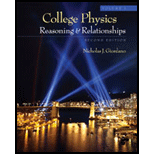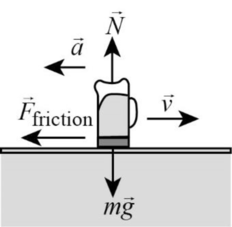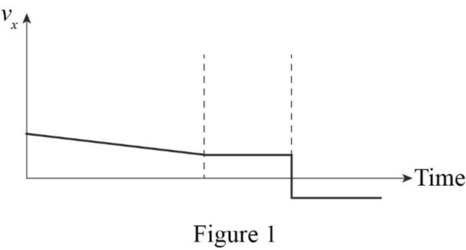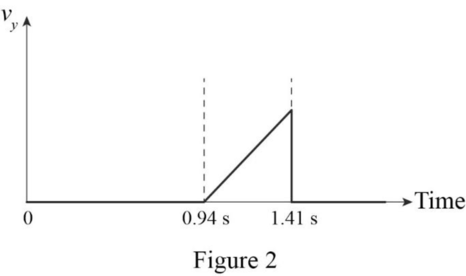
Concept explainers
(a)
The distance
(a)
Answer to Problem 72P
The distance
Explanation of Solution
Write the mathematical expression for Newton’s second law.
Here,
Write the
Here,
After the mug leaves the bar the projectile motion can be considered.
Consider the free body diagram.

Apply Newton’s second law to the free body diagram.
Write the expression for the
Substitute,
Write the expression for
Here,
Substitute equation (III) in(IV).
Here,
Write the kinematic equation for displacement in
Substitute,
Write the kinematic equation for displacement in
Conclusion:
Substitute,
Substitute,
Substitute,
Substitute,
Therefore, the distance
(b)
The velocity of the mug.
(b)
Answer to Problem 72P
The velocity of the mug is
Explanation of Solution
Write the expression for velocity along
Here the
Write the expression for the magnitude of the velocity.’
Write the expression for the direction of velocity.
Conclusion:
Substitute,
Substitute,
Substitute,
Therefore, the velocity of the mug is
(c)
The velocity time graph for both
(c)
Answer to Problem 72P
The velocity time graph for both
Explanation of Solution
Write the expression for the
Conclusion:
Substitute,
The velocity time graph for velocity in

The velocity time graph for velocity in

Therefore, the velocity of the mug is
Want to see more full solutions like this?
Chapter 4 Solutions
College Physics, Volume 1
- In a classic clip on Americas Funniest Home Videos, a sleeping cat rolls gently off the top of a warm TV set. Ignoring air resistance, calculate the position and velocity of the cat after (a) 0.100 s, (b) 0.200 s, and (c) 0.300 s.arrow_forwardA skier with a mass of 60 kg is sliding down a snowy slope, the slope with an angle of 30 degrees above the horizontal as shown in the figure. Find the acceleration for the skier if friction is known to be 45.0 N. Assuming no air resistance and g=10m/s^2. a) 10 m/s^2 b) 0.75 m/s^2 c) 4.25 m/s^2 d) 1.33 m/s^2arrow_forwardDescending from rest at the last peak (height 20 m above the ground level) on a roller-coaster track, a car, of mass 750 kg, hits at the end of a horizontal stretch of shallow water, which exerts the average braking force of 920 N. How far does the car splash through the water before it stops?a. 210 m b. 160 m c. 130 m d. 90 m e. 50 marrow_forward
- A rocket is launched to travel vertically upward with a constant velocity of 20 m/s. After travelling for 35 seconds, the rocket develops a snag and its fuel supply is cut off. The rocket then travels like a free body. The height achieved by it is: A) 680 m B) 720 m C) 800 m D) 700 marrow_forwardA player kicks a soccer ball in a high arc toward the opponent's goal. At the highest point in its trajectory, whichis true? both the velocity and the acceleration of the soccer ball are zero. neither the ball's velocity nor its acceleration is zero. the ball's acceleration is zero, but its velocity is not zero. the ball's acceleration points upward. Why is it more difficult to start pushing a couch from rest than it is to maintain its motion at constant velocity? the normal force is larger when the couch is at rest. Because μk > μs It only seems more difficult Because μs > μkarrow_forwardTwo snow-covered peaks are at elevations of 862 m and 741 m above the valley between them. If a skier starts from rest on the higher peak and just coasted down without exerting any effort, at what speed would he arrive at the lower peak?arrow_forward
- For a body moving with uniform acceleration its final velocity equals _________________. A) average velocity - initial velocity B) 2 x average velocity - initial velocity C) 2 x average velocity + initial velocity D) average velocity + initial velocityarrow_forwardA car of mass 2,000 kg coasts down the highway with a constant velocity of v = 15.0 m/s. The car then goes over a hill 3.00 m vertically high. Which of these best describes the velocity of the car at the top of the hill? a. it's 15.0 m/s b. it's zero m/s c. it's less than 15.0 m/s d. it's greater than 15.0 m/s e. none of thesearrow_forwardA train composed of a small engine car and a massive cargo car are connected as they move along a track. The speed of the small engine car is ____(blank 1)___ the speed of the massive cargo car. The magnitude of the acceleration of the small engine car is ____(blank 2)___ the magnitude of the acceleration of the massive cargo car because ____(blank 3)___ .arrow_forward
- You wake up in a strange room, and this time you drop a ball from a height of 1.60 m, and observe that it hits the floor 0.400 s after you drop it. In this case you suspect you are in deep space, far from any planet or star, and that your rocket is accelerating due to the push of its own engines under the floor. In this case, what must the acceleration of your rocket be? (Ignore air resistance). 36.0 m/s^2 36.0 m/s^2 10.0 m/s^2 15.0 m/s^2arrow_forwardWhich of the following statements is false regarding an object thrown upward from the ground and eventually falling back to its original height? (Assume negligible air resistance.) a.The acceleration of the object depends on the mass of the object. b.The speed at which the object is thrown upward is the same as the speed at which it lands. c.The acceleration is the same as the object rises and falls. d.The time taken for the object to reach its maximum height is equal to the time taken to fall back to its original height.arrow_forwardA trained sea lion slides from rest with constant acceleration down a 3.0-m-long ramp into a pool of water. If the ramp isinclined at an angle of u = 23° above the horizontal and the coefficient of kinetic friction between the sea lion and theramp is 0.26, how much time does it take for the sea lion to make a splash in the pool?arrow_forward
 Classical Dynamics of Particles and SystemsPhysicsISBN:9780534408961Author:Stephen T. Thornton, Jerry B. MarionPublisher:Cengage Learning
Classical Dynamics of Particles and SystemsPhysicsISBN:9780534408961Author:Stephen T. Thornton, Jerry B. MarionPublisher:Cengage Learning Principles of Physics: A Calculus-Based TextPhysicsISBN:9781133104261Author:Raymond A. Serway, John W. JewettPublisher:Cengage Learning
Principles of Physics: A Calculus-Based TextPhysicsISBN:9781133104261Author:Raymond A. Serway, John W. JewettPublisher:Cengage Learning

